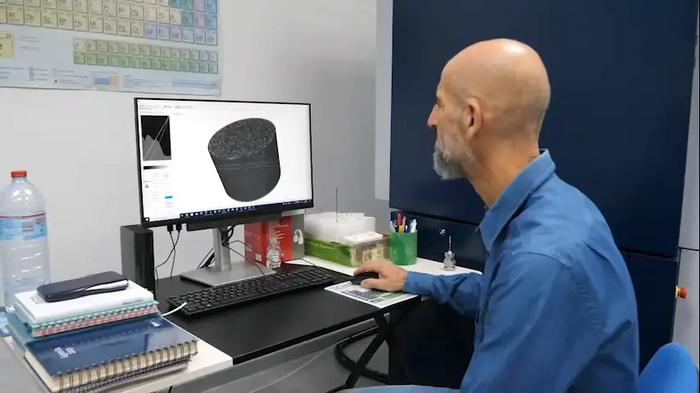For the first time in the history of the University of Malaga, a scientist from this institution has obtained one of the ERC Advanced Grants (AdG) granted by the European Research Council. The recipient is the Professor of Inorganic Chemistry Miguel Ángel García Aranda who, through this program -considered one of the most competitive and prestigious of all grants awarded by the European Commission-, will receive €2.5 million over the next 5 years to continue his research that advances toward the development of low-carbon (CO2) cements that contribute to mitigating climate change, but with competitive performances.

Credit: University of Malaga
For the first time in the history of the University of Malaga, a scientist from this institution has obtained one of the ERC Advanced Grants (AdG) granted by the European Research Council. The recipient is the Professor of Inorganic Chemistry Miguel Ángel García Aranda who, through this program -considered one of the most competitive and prestigious of all grants awarded by the European Commission-, will receive €2.5 million over the next 5 years to continue his research that advances toward the development of low-carbon (CO2) cements that contribute to mitigating climate change, but with competitive performances.
Specifically, this UMA project, which has been selected after undergoing a complex evaluation process in which thousands of researchers of excellence compete internationally, works in the production of less polluting cements without prejudice to their durability. By using advanced microscopic techniques in 4D (3D + time), this research seeks to accelerate the hydration of cements, maintaining all their performances.
“This finding will represent a disruptive leap, since there are already results related to cements with a lower carbon footprint, but with slow hydration kinetics in the first three days, so its general use is greatly limited”, explains García Aranda.
Perseverance
The scientist of the University of Malaga already has to his credit this notorious aid from the European Union granted only to outstanding researchers with a track-record of significant research achievements in the last decade.
It was in 2015 when he began to consider the idea of applying, but it was not until May 2019 that he was eligible for the grant for the first time, after 4 years of intense preparation.
He was not selected in this first attempt, but his evaluation was positive enough to keep trying. Two years later, in 2021, he tried one more time, but again with no success, although he received better comments than in the previous call, which prompted him to move forward.
Last November, again two years later, after a third attempt, he received the “big news” that he had passed the first phase, a highly demanding process. From that moment on, García Aranda underwent three months of “hard specialized training” to get through the second phase of evaluation. And get through he did. “It has not been easy, but we must never lose faith. I have learned a lot in these nine years. Perseverance in science, as in many other areas of life, bears fruit,” he says.
ERC Advanced Grants: €652 million for outstanding researchers in Europe
The current call for ERC Advanced Grant has registered 1,829 applications of which, finally, 255 proposals from 32 different nationalities have been financed with a total investment of €652 million from the European Union. Miguel Ángel García Aranda’s project has been one of the 14 Spanish projects that has managed to convince the evaluation panel members, organized in various thematic panels that are made up of experts of the highest international prestige.
The economic injection of €2.5 million that this UMA professor will receive will allow him to continue his innovative line of research over the next five years, and engage 6 new researchers, 3 doctoral students and another 3 postdoctoral students, who will join his scientific team.
García Aranda is the first researcher at the University of Malaga to obtain the ERC Advanced Grant. Until now, the Malaga institution has had three Starting Grants from the ERC program obtained by researchers David Posé (Molecular Biology and Biochemistry), Diego Romero (Microbiology) and Juan Miguel Morales (Applied Mathematics).
Starting Grant, aimed at researchers who have held a PhD for 2-7 years; Consolidator Grant, for those who have held a PhD for 7-12 years and, finally, Advanced Grant, intended for active researchers who have a track-record of significant research achievements in the last 10 years, are the main ERC schemes.
Miguel Ángel García Aranda is Professor of Inorganic Chemistry at the University of Malaga since 2011. He graduated in Chemical Sciences in 1988 by the UMA and obtained a PhD in the same specialty in 1992, also at this same institution.
His line of research focuses on the study of cement hydration to improve its performance. “Concrete is the most used artificial material. It has extraordinary properties, since it is applied as a liquid and when setting it becomes a rock that can maintain its properties for more than a century. However, the carbon footprint of building materials is enormous, accounting for 8 percent of all human emissions of CO2”, he says.
His research is therefore focused on developing cements with a 50 percent lower carbon footprint, replacing part of Portland cement with much less polluting materials. “The hydration of these new cements has to be understood and accelerated. The X-ray microscopy techniques currently under development allow us to know and control these processes in a very detailed way”, explains García Aranda.
Scientific director of the ALBA synchrotron, on secondment from the UMA (2013-2019), in this position he coordinated the user assistance program, as well as the future scientific use of the facility, apart from supervising a group of more than 75 scientists and technologists from 15 nationalities.
Likewise, from January 2018 to December 31, 2020, he was chairman of the board of the European Synchrotron Radiation Facility (ESRF), a European synchrotron in Grenoble. This synchrotron is funded through the cooperation of 21 nations (13 member states and 8 associated states) and has more than 800 employees.



